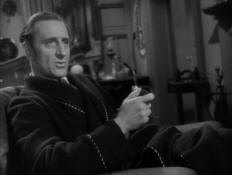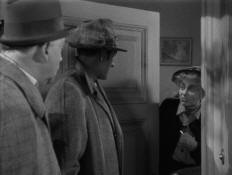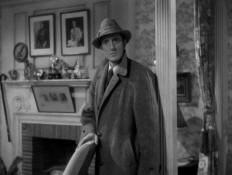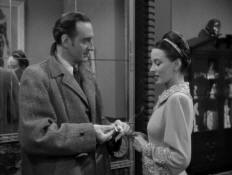Dressed
to Kill
|
 Holmes is intrigued by Stinky's story. |
 Stinky shows Holmes the plain music box. |
Watson's old school chum Julian Emery ("Stinky") stops by for a visit. When asked about the bandage on his head, Stinky explains that someone broke into his house and bonked him on his head. He thinks it's strange that the thief stole a cheap music box rather than the more valuable ones that were in plain sight. Holmes finds this fact intriguing. Holmes and Watson go to Stinky's house and they look over the music boxes. Stinky shows them the music box that he bought at the auction, explaining the it's almost identical to the stolen box. (Apparently the thief got the wrong box!) Holmes immediately suspects cause and effect between Stinky's auction purchase and the robbery. Stinky says that he bought the plain cheap box because of the interesting tune. After hearing it just once, Holmes memorizes the tune.
After Holmes and Watson have left, Julian Emery receives a visit from Hilda Courtney. She's after the music box, of course, and uses her feminine charms on Julian Emery to persuade him to part with the box. She has nearly succeeded when her chauffer, Hamid, sees Emery touching her; in a jealous rage Hamid throws a knife at Emery, killing him.
Holmes joins the police investigating the murder of Watson's old friend. Noticing that the plain music box with the unusual tune is missing, Holmes visits Gaylord's auction house and learns that Emery's music box was one of three identical boxes made by an inmate at Dartmoor Prison. Holmes deduces that somehow the boxes were a form of communication with the inmates friends on the outside. Believing that the people who bought the other two boxes may be in danger, Holmes tracks them down.
At the Kilgour home the "charwoman" answers the door and allows Holmes and Watson to wait for the Kilgours in the living room. She says she must go do the shopping. While waiting, Holmes hears banging in the closet, and finds Kilgour's little girl tied up. He then realizes that he's been duped by the "charwoman"—Hilda Courtney in disguise!
|
"Dressed to Kill" The astuteness of Sherlock Holmes, in the person of Basil Rathbone, is once again on display in "Dressed to Kill," the latest of Universal's works of bafflement. Rathbone, as the master of deduction, strides through his role with a smoothness born of long practice. Nigel Bruce, as the urbane Dr. Watson, offers his capable support, while the beauteous Patricia Morison is Rathbone's dangerous antagonist. This is one of the more ingenious of Conan Doyle's stories, and should intrigue mystery devotees. Rathbone and Bruce, and an unknown gang of criminals, are on the trail of three music boxes which offer the clues to the whereabouts of Bank of England engraving plates. The detective possesses one of the boxes, and has reason to believe that the gang has acquired the other two. Miss Morison traps Rathbone through a ruse and orders her two accomplices, Frederick Worlock and Harry Cording, to dispose of him. It is then child's play for her to get the third music box from Bruce. The resourceful Rathbone escapes, however, and captures the band in the act of acquiring the plates, preliminary to flooding England with shiny five-pound banknotes. Leonard Lee's screenplay, from Frank Gruber's adaptation, is adequate. Roy William Neill produced and directed, while Howard Benedict was executive producer. Delos Jewkes sings a music hall ballad in an appropriate sequence. Others in support are Edmund Breon, Patricia Morison Cameron, Carl Harbord and Topsy Glyn. Charles Ryweck —Motion Picture Daily, May 28, 1946 |
The buyer of the third music box was Evelyn Clifford, the owner of a toy store. When Hilda Courtney and Colonel Cavanaugh visit the toy shop, they discover that the music box they seek has been sold—to Sherlock Holmes!
Holmes notes that the tune of the music box from the toy shop is nearly identical to the tune from Emery's music box, and he deduces that the tune is a code of some sort. He seeks the help of former safe cracker Joe Sisto, who plays piano in a pub that is a meeting place for buskers (street artists). Holmes plays the music box tune on the piano. Joe recognizes the tune as "The Swagman" but says that Mr. Holmes isn't playing it exactly right. The music box tunes have slight variations on the "Swagman" tune as it was written.
When Holmes and Watson return to Baker Street, they find their flat has been ransacked. Nothing was stolen, but a cigarette stub was left behind. Holmes stays up all night trying to work out the music box code. The next morning Watson opens the curtains and observes, "Look, Holmes, it's morning." To which Holmes retorts, "Allow me to congratulate you on a brilliant piece of deduction!" Watson provides the clue to solving the music box puzzle when he talks about his childhood piano teacher numbering the piano keys for him. Each note that's a variation on the original tune corresponds to a letter of the alphabet. From the tune from the toy store music box and the tune that Holmes memorized from Emery's music box Holmes is able to figure out two thirds of the message: behind books third shelf secretary dr s
 The Kilgour charwoman is Hilda Courtney in disguise. |
 Holmes hears a sound coming from the closet. |
Holmes leaves Scotland Yard in charge of finding the mysterious "Dr. S" and follows up on the clue of the cigarette left in his flat. A woman in a tobacco shop identifies the unusual tobacco that Hilda Courtney buys, and gives Courtney's address to Holmes. It turns out that leaving the cigarette was intentional. Mrs. Courtney had read Holmes's monograph "on the ashes of 140 different varieties of tobacco," and was certain that he wouldn't be able to resist her tobacco lure. Hamid and Cavanaugh handcuff Holmes and take him away to be killed at another location. While in the car, Holmes distracts Cavanaugh and manages to palm the handcuff key. In a garage, Hamid and Cavanaugh hang Holmes from a hook on a ceiling beam, and leave him to die by poison gas. Holmes manages to free himself in time. (Rathbone is doubled by a stunt man in this scene.1)
Meanwhile, Hilda Courtney goes to 221B Baker Street and Watson lets her in. Using the smoke bomb trick she read about in "A Scandal in Bohemia," Mrs. Courtney tricks Watson into revealing where the music box is hidden. When Holmes returns to the flat and hears what happened, he tells Watson he can console himself that at least Mrs. Courtney reads his stories. As Watson tends to Holmes's wounds, he quotes Dr. Samuel Johnson, and the light bulb goes on in Holmes's head.
Dr. Samuel Johnson's house in Gough Square is a museum. Davidson hid the Bank of England plates in Dr. Johnson's secretary. Mrs. Courtney, Cavanaugh and Hamid join a group on a tour of the museum, and stay behind when they spot the secretary. No sooner have they got the plates in their hands, than Sherlock Holmes and the police are there to arrest them.
|
"DRESSED TO KILL" ONE OF THE BETTER SHERLOCK HOLMES MYSTERIES This ingeniously-told and interest-holding mystery yarn is made to order for the Sherlock Holmes devotees and action fans in general. It will also make a good supporting dualler in the naborhoods. Fourteenth (and reportedly the last) of Universal's programmers based on Sir Arthur Conan Doyle's famous detective yarns, this is also one of the best of the series. The calm and resourceful Holmes and his blundering, but well-meaning crony, Dr. Watson, have a hard nut to crack as they follow the trail of three identical prison-made musical boxes whose tunes hold a message for a gang of unscrupulous criminals. A beautiful and strikingly-gowned adventuress (hence the title) is their chief adversary and Holmes gets himself into several tight spots before he brings the crooks to justice. Basil Rathbone's imperturbable demeanor as Holmes and Nigel Bruce's blustering as Dr. Watson are again neatly contrasted throughout and Patricia Morison is well cast as the attractive adventuress. Ian Wolfe, Frederic Worlock and Edmond Breon give fine character portrayals and Delos Jewkes' singing of a beer-hall ballad, "Ya Never Know Just 'oo Yer Gonna Meet," adds a novel lighter touch. Three identical music boxes, made in Dartmoor Prison and auctioned in London, hold the key to the hiding place of a stolen set of Bank of England plates for engraving five-pound notes. After one of the purchasers is murdered and a second is robbed of her box, Sherlock Holmes (Basil Rathbone) is convinced that a gang headed by Patricia Morison and Frederic Worlock will stop at nothing to get the hidden bank plates. Because Holmes lacks the evidence to arrest them, he gets the third musical box and decodes a message from its tune indicating that the plates are hidden in the library of a a Doctor "S." By a clever ruse, Miss Morison's confederates capture Holmes and she steals the third box from Dr. Watson (Nigel Bruce) before the detective can free himself. However, Dr. Watson unconsciously suggests a clue to the hiding place of the bank-note plates and Holmes arrives at the Memorial Home of Dr. Samuel Johnson in time to trap Miss Morison in the act of finding the plates before he turns her and her confederates over to the police. Leyendecker —Independent Exhibitors Film Bulletin, June 24, 1946 |
Although the film was made in Hollywood, the director made an effort to make the studio reproduction as authentic as possible. Roy William Neill obtained a floor plan and photos of the interior of Dr. Johnson's house from a London contact.2
Except for the use of the smoke bomb trick that appeared in "A Scandal in Bohemia," the plot of Dressed to Kill is original, and not based on any of Conan Doyle's Sherlock Holmes stories.
It's never clearly explained why Davidson was so anxious to tell Hilda Courtney where the Bank of England plates were. Perhaps he was afraid they would be accidentally discovered. However, they seemed to be very well-hidden. In a locked cabinet in a museum, it's not likely they would be found accidentally.
A memorable Sherlock Holmes quote from this film is: "The truth is only arrived at through the painstaking process of eliminating the untrue." This statement sounds very Holmesian, but it doesn't appear in any of the stories. The more familiar quote from the Holmes canon is, "When you have eliminated the impossible, whatever remains, however improbable, must be the truth" (from The Sign of Four).
 Holmes plays the music box tune for Joe Sisto. |
 Holmes questions Mrs. Hudson about the break-in. |
Dressed to Kill began filming on January 22, 1946. Dennis Hoey was working on another film at that time, so he was unavailable to play Inspector Lestrade in Dressed to Kill. As a result, the Lestrade character was rewritten as Inspector Hopkins.
The film was released on June 7, 1946. Director Roy William Neill, who directed Rathbone and Bruce in ten other films (Sherlock Holmes and the Secret Weapon, Sherlock Holmes in Washington, Sherlock Holmes Faces Death, The Spider Woman, The Scarlet Claw, The Pearl of Death, The House of Fear, The Woman in Green, Pursuit to Algiers, Terror by Night) died six months later on December 14, 1946.
Patricia Morison, who played Hilda Courtney, recalled the following about working with Basil Rathbone and Nigel Bruce: "Of course, Nigel Bruce—we called him 'Willy'—was an absolute darling! It was a lot of fun. Basil and 'Willy' broke for tea every afternoon on the set—the whole crew and everybody! The tea tray would come in with a silver service and everything." —quoted in Universal Horrors (Tom Weaver, Michael Brunas, John Brunas, 2007)
Frederic Worlock and Basil Rathbone were no strangers to one another. Worlock was a member of Frank Benson's Shakespeare company during the years that Rathbone was training with Benson. Worlock and Rathbone appeared together on Broadway in Julius Caesar (1927) and The Grand Duchess and the Waiter (1925). At that time Worlock was married to Elsie Ferguson, who played the Grand Duchess opposite Rathbone, and was also a family friend. In 1959 Worlock and Rathbone were back on Broadway in leading roles in J. B. In films, Rathbone and Worlock appeared together in Sherlock Holmes in Washington, Sherlock Holmes Faces Death, The Woman in Green, Pursuit to Algiers, Terror by Night, Dressed to Kill, and the non-Sherlock Holmes film International Lady (1941).
Mary Gordon, Harry Cording, Holmes Herbert, Leyland Hodgson, Ian Wolfe and Olaf Hytten (players in Dressed to Kill) appeared with Rathbone and Bruce in several other Sherlock Holmes films:
- Mary Gordon appeared as Mrs. Hudson in all of the Rathbone/Bruce Sherlock Holmes films except for The Scarlet Claw, The House of Fear, Pursuit to Algiers, and Terror by Night.
- Harry Cording's credits include The Adventures of Sherlock Holmes, Sherlock Holmes and the Voice of Terror, Sherlock Holmes and the Secret Weapon, The Spider Woman, The Pearl of Death, The House of Fear, and Terror by Night. Cording also acted with Rathbone in Anna Karenina (1935), Captain Blood (1935), The Adventures of Marco Polo (1938), The Adventures of Robin Hood (1938), Son of Frankenstein (1939), The Sun Never Sets (1939), and The Tower of London (1939).
- Holmes Herbert appeared in The Adventures of Sherlock Holmes, Sherlock Holmes and the Secret Weapon, Sherlock Holmes in Washington, The Pearl of Death, and House of Fear. Herbert's credits also include Captain Blood (1935), The Adventures of Robin Hood (1938), The Sun Never Sets (1939), and The Tower of London (1939).
- Leyland Hodgson had roles in The Adventures of Sherlock Holmes, Sherlock Holmes and the Voice of Terror, Sherlock Holmes and the Secret Weapon, Sherlock Holmes in Washington, The Pearl of Death, and Terror by Night. Hodgson also appeared in A Feather in Her Hat (1935), Confession (1937), The Adventures of Robin Hood (1938), International Lady (1941), and Frenchman's Creek (1944).
- Ian Wolfe (who appeared in The Scarlet Claw, The Pearl of Death, and Sherlock Holmes in Washington) also acted with Rathbone in Paris Calling (1941), and Romeo and Juliet (1936).
- Olaf Hytten's credits include Sherlock Holmes and the Voice of Terror, Sherlock Holmes Faces Death, The Scarlet Claw, The Woman in Green, and Pursuit to Algiers. Hytten also appeared with Rathbone in Anna Karenina (1935), A Feather in Her Hat (1935), The Adventures of Robin Hood (1938), The Sun Never Sets (1939), and Rio (1939).
In addition to Dressed to Kill, Guy Kingsford appeared in Sherlock Holmes and the Secret Weapon. Sally Shepherd played roles in three Sherlock Holmes films: The House of Fear, The Woman in Green, and Dressed to Kill.
Dressed to Kill is a popular movie title; other films with the same title (made in 1928, 1941, 1966 and 1980) are unrelated to this Sherlock Holmes yarn.
|
Dressed to Kill AUDIENCE SLANT (Adult): The fans, for whom this picture was made, will find it exciting and suspenseful when their hero gets into a tight spot, and the story a challenge to their ingenuity in solving a mystery in advance. BOX-OFFICE SLANT: One of the better of the Sherlock Holmes films. Plot: The sale of three music boxes at an auction, starts a series of mysterious killings. Even Holmes becomes involved, and his life is in danger, for he acquires one in order to bait the killer. But he eventually solves the mystery and find the Bank of England money plates around which the crime revolves. Comment: This latest Sherlock Holmes picture is a very good mystery; much more logical than most. Story is well-contrived and performances splendidly handled. The fans, for whom this picture was made, will be delighted by a number of thrills and plenty of excitement and suspense, especially in the sequence where their infallible hero gets into a tight spot. They'll have a fine time biting their nails while Holmes gets out of the predicament. These same armchair detectives will enjoy the challenge given them in trying to solve the mystery. Good performances and the fine direction of Roy William Neill help the melodramatic sequences along, and the natural interpretations both Basil Rathbone and Nigel Bruce give to the Holmes and Watson roles, makes the picture a smooth running bit of entertainment. Rest of the cast is fine too, especially Patricia Morison and Frederic Worlock ... the villains. —Showmen's Trade Review, May 25, 1946 |
With its devilishly clever plot, the film is entertaining. It's not the best one in the series, but not the weakest one, either. Ever since the release of Dressed to Kill critics have been divided over it. Some liked it a lot, others hated it.
In his book Basil Rathbone: His Life and His Films, Michael Druxman describes the film as "a lemon"—one that ended the series on a sour note. He added that Basil Rathbone and Nigel Bruce seemed uninterested in the screenplay, and Roy William Neill's direction lacked inspiration. "Supporting performances were inferior to those in earlier episodes of the series, as were the production values, which appeared paltry. . . . a dismal conclusion to an often exceptional motion picture series."
In contrast, Jack D. Grant stated, "Story-wise, Dressed to Kill heads the list of the modern Sherlock Holmes pictures ... it poses a puzzle worthy of the Doyle tradition and gives Doctor Watson a large, if unwitting share in pointing to the solution" (The Hollywood Reporter, May 16, 1946).
 Holmes questions the tobacconist |
 Holmes shows Mrs. Courtney the cigarette stub she left in his flat. |
.
Notes
1 Chris Steinbrunner and Norman Michaels, The Films of Sherlock Holmes
(Citadel Press, 1978), 184.
2 Amanda Field, England's Secret Weapon, (Middlesex University
Press, 2009), 145.
.
See more photos and reviews on Page Two. See
Posters, Lobby Cards and Promo Photos on
Page Three!
|
...
| Images on this page are from the film
Dressed to Kill.
|
Dressed to Kill is
available on DVD: Click to order |
DVD also available as part of The Sherlock Holmes
Collection, Volume 3: Click to order |
Note: Dressed to Kill is one of the four Rathbone/Bruce Sherlock Holmes films that is in the public domain. That means that anyone can legally produce and sell a DVD of this film. Consequently, it's easy to find cheap DVDs of Dressed to Kill. But these cheap ones are also cheap quality. The links above are for the digitally remastered, high-quality DVDs produced by MPI Home Video. Anything else is a waste of money!






